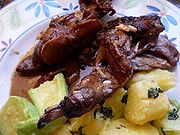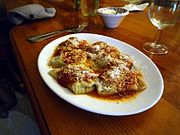
Maltese cuisine
Encyclopedia
Maltese cuisine refers to the dishes identified as Maltese
. Reflecting Maltese history
, it shows strong Sicilian and English influences as well as influences of Spanish
, Maghrebin and Provençal cuisines.
Italian (specifically Sicilian), Middle Eastern and Arabic foods exerted a strong influence, but the presence in Malta of the Knights of St John and, more recently, the British brought elements from further afield
The Knights hailed from many European countries; particularly, France, Italy and Spain. They brought influences from these countries. Aljotta, for example, a fish broth with plenty of garlic, herbs, and tomatoes is the Maltese adaptation of bouillabaisse
. The Knights' contacts and wealth brought also food from the New World; it has been suggested that Malta may have been one of the first countries in Europe (after Spain) where chocolate was first tasted.
The British military presence meant a market of a garrison and their families and, later, mass tourism from the UK. British food products, condiments and sauces like English mustard, Bovril
, HP Sauce
and Worcestershire sauce
are still a subtle but pervasive presence in Maltese cooking.
Other imports were only nominal. While the Maltese word "aljoli" is likely to be a loan word, the Maltese version of the sauce does not include any egg as in aioli
; instead it is based on herbs, olives, anchovies and olive oil. Similarly, while the Maltese word "taġen" is related to "tajine
" in Maltese the word refers exclusively to a metal pan.
 There are a number of junctures in which development in Maltese cuisine related to issues of identity. The most significant example is the traditional Maltese fenkata (eating stewed rabbit), often identified as the national dish, quite possibly started off as a form of symbolic resistance to the hunting restrictions imposed by the Knights of St John. The dish was to become popular after the lifting of restrictions in the late 18th century (and by which time the indigenous breed had multiplied and prices dropped) and the domestication of rabbits, a technique which could have been imported from France thanks to the French Knights.
There are a number of junctures in which development in Maltese cuisine related to issues of identity. The most significant example is the traditional Maltese fenkata (eating stewed rabbit), often identified as the national dish, quite possibly started off as a form of symbolic resistance to the hunting restrictions imposed by the Knights of St John. The dish was to become popular after the lifting of restrictions in the late 18th century (and by which time the indigenous breed had multiplied and prices dropped) and the domestication of rabbits, a technique which could have been imported from France thanks to the French Knights.
The popularity of pork and its presence in various dishes could be attributed to Malta being on the edge of the Christian world. Consuming a food which is taboo in the Muslim culinary culture could have been a way of self-identification by distinguishing oneself from the other. In addition to pork dishes (such as grilled pork cuts or stuffed flank) and the exclusive predominance of pork in indigenous Maltese sausages, adding some pork to dishes such as kawlata (a vegetable soup) and ross il-forn (baked rice) have been common practice in the Maltese vernacular cuisine for centuries.
For the Café Europe
event held during the Austrian Presidency of the EU
in 2006 the "representative" Maltese pastry chosen was the maqrut.
 Despite Malta's small size there are some regional variations. This is especially the case with Gozo
Despite Malta's small size there are some regional variations. This is especially the case with Gozo
. This is evidenced in some names such as the Gozitan cheeselet
(ġbejna t'Għawdex) and ftira Għawdxija, a flatbread
topped or filled with potatoes or ġbejniet with eggs, grated cheese, tomatoes, anchovies, olives, ricotta and Maltese sausage as other possible ingredients.
 Other Gozitan variants include the use of ingredients. Gozitan cheeselets, for example, are used as filling for ravioli
Other Gozitan variants include the use of ingredients. Gozitan cheeselets, for example, are used as filling for ravioli
instead of the usual ricotta
.
 The strongest seasonal variations are seen in desserts and sweets. Prinjolata, kwareżimal, karamelli tal-ħarrub, ftira tar-Randan, figolla and qagħaq tal-għasel are all examples of sweets associated with a particular season.
The strongest seasonal variations are seen in desserts and sweets. Prinjolata, kwareżimal, karamelli tal-ħarrub, ftira tar-Randan, figolla and qagħaq tal-għasel are all examples of sweets associated with a particular season.
Because Catholic fasting
during Lent
involved mostly meats and dairy products, fish such as Lampuki
were a popular dish during this period as were stewed snails
, stuffed artichoke
s and fritter
s of ġbejna
, vegetables or fish (particularly whitebait
and salted cod).
During the Holy Week
bakers also bake a large bagel
typically studded with some almonds on top called qagħqa tal-appostli (lit. apostles' bagel). Usually coinciding with the spring, there are also seasonal variations to certain dishes at the time of Lent
as in, for example, adding fresh broad beans to dishes such as kusksu (a vegetable and pasta dish).
During the month of November għadam tal-mejtin (lit. bones of the dead) are prepared. These are similar to figolla but made in the shape of a bone.
Malta
Malta , officially known as the Republic of Malta , is a Southern European country consisting of an archipelago situated in the centre of the Mediterranean, south of Sicily, east of Tunisia and north of Libya, with Gibraltar to the west and Alexandria to the east.Malta covers just over in...
. Reflecting Maltese history
History of Malta
Malta has been inhabited since it was settled around 5200 BC from Sicily. It was settled by the Phoenicians and later the Greeks who named the island Μελίτη meaning "honey sweet" in reference to Malta's endemic variety of bee.-B.C.:*5000 First Human settlers...
, it shows strong Sicilian and English influences as well as influences of Spanish
Spanish cuisine
Spanish cuisine consists of a variety of dishes, which stem from differences in geography, culture and climate. It is heavily influenced by seafood available from the waters that surround the country, and reflects the country's deep maritime roots...
, Maghrebin and Provençal cuisines.
History
Malta's history and geography had an important influence on its cuisine. Having had to import most of its foodstuffs, positioned along important trade routes and having to cater for the resident foreign powers who ruled the islands, opened Maltese cuisine to outside influences from very early on. Foreign dishes and tastes were absorbed, transformed and adapted.Italian (specifically Sicilian), Middle Eastern and Arabic foods exerted a strong influence, but the presence in Malta of the Knights of St John and, more recently, the British brought elements from further afield
The Knights hailed from many European countries; particularly, France, Italy and Spain. They brought influences from these countries. Aljotta, for example, a fish broth with plenty of garlic, herbs, and tomatoes is the Maltese adaptation of bouillabaisse
Bouillabaisse
Bouillabaisse is a seafood soup made with various kinds of cooked fish and shellfish and vegetables, flavored with a variety of herbs and spices such as garlic, orange peel, basil, bay leaf, fennel and saffron. Bouillabaisse is a traditional Provençal fish stew originating from the port city of...
. The Knights' contacts and wealth brought also food from the New World; it has been suggested that Malta may have been one of the first countries in Europe (after Spain) where chocolate was first tasted.
The British military presence meant a market of a garrison and their families and, later, mass tourism from the UK. British food products, condiments and sauces like English mustard, Bovril
Bovril
Bovril is the trademarked name of a thick, salty meat extract, developed in the 1870s by John Lawson Johnston and sold in a distinctive, bulbous jar. It is made in Burton upon Trent, Staffordshire, owned and distributed by Unilever UK....
, HP Sauce
HP Sauce
HP Sauce is a popular brown sauce originally produced by HP Foods in the UK, now produced by H.J. Heinz in the Netherlands.It is the best-known brand of brown sauce in the United Kingdom and Canada as well as the best selling, with 71% of the UK market....
and Worcestershire sauce
Worcestershire sauce
Worcestershire sauce , or Worcester sauce is a fermented liquid condiment; primarily used to flavour meat or fish dishes.First made at 60 Broad Street, Worcester, England, by two dispensing chemists, John Wheeley Lea and William Henry Perrins, the Lea & Perrins brand was commercialised in 1837 and...
are still a subtle but pervasive presence in Maltese cooking.
Other imports were only nominal. While the Maltese word "aljoli" is likely to be a loan word, the Maltese version of the sauce does not include any egg as in aioli
Aioli
Aioli ) is a traditional sauce made of garlic, olive oil, and egg. There are many variations, such as the addition of mustard or, in Catalonia, pears. It is usually served at room temperature. The name aioli comes from Provençal alh 'garlic' is a traditional sauce made of garlic, olive oil,...
; instead it is based on herbs, olives, anchovies and olive oil. Similarly, while the Maltese word "taġen" is related to "tajine
Tajine
A tajine, or tagine , is a dish from North Africa, that is named after the special earthenware pot in which it is cooked. A similar dish, known as tavvas, is found in the cuisine of Cyprus. The traditional tajine pot is formed entirely of a heavy clay, which is sometimes painted or glazed...
" in Maltese the word refers exclusively to a metal pan.
Cuisine and Identity

The popularity of pork and its presence in various dishes could be attributed to Malta being on the edge of the Christian world. Consuming a food which is taboo in the Muslim culinary culture could have been a way of self-identification by distinguishing oneself from the other. In addition to pork dishes (such as grilled pork cuts or stuffed flank) and the exclusive predominance of pork in indigenous Maltese sausages, adding some pork to dishes such as kawlata (a vegetable soup) and ross il-forn (baked rice) have been common practice in the Maltese vernacular cuisine for centuries.
For the Café Europe
Café Europe
This article is about the event, for the Croatian novel see, Café EuropaCafé Europe, Café d'Europe or also Café Europa was a cultural initiative of the Austrian presidency of the European Union, held on Europe Day in 27 cafés of the capitals of the then 25 EU member states and the two countries...
event held during the Austrian Presidency of the EU
Presidency of the Council of the European Union
The Presidency of the Council of the European Union is the responsibility for the functioning of the Council of the European Union that rotates between the member states of the European Union every six months. The presidency is not a single president but rather the task is undertaken by a national...
in 2006 the "representative" Maltese pastry chosen was the maqrut.
Regional

Gozo
Gozo is a small island of the Maltese archipelago in the Mediterranean Sea. The island is part of the Southern European country of Malta; after the island of Malta itself, it is the second-largest island in the archipelago...
. This is evidenced in some names such as the Gozitan cheeselet
Gbejna
Ġbejna is a round cheeselet made in Malta from goat’s or sheep's milk, salt and rennet...
(ġbejna t'Għawdex) and ftira Għawdxija, a flatbread
Flatbread
A flatbread is a simple bread made with flour, water, and salt and then thoroughly rolled into flattened dough. Many flatbreads are unleavened: made without yeast or sourdough culture: although some flatbread is made with yeast, such as pita bread....
topped or filled with potatoes or ġbejniet with eggs, grated cheese, tomatoes, anchovies, olives, ricotta and Maltese sausage as other possible ingredients.

Ravioli
Ravioli are a traditional type of Italian filled pasta. They are composed of a filling sealed between two layers of thin egg pasta dough and are served either in broth or with a pasta sauce. The word ravioli is reminiscent of the Italian verb riavvolgere , though the two words are not...
instead of the usual ricotta
Ricotta
Ricotta is an Italian dairy product made from sheep milk whey left over from the production of cheese. Although typically referred to as ricotta cheese, ricotta is not properly a cheese because it is not produced by coagulation of casein...
.
Seasonal

Because Catholic fasting
Fasting
Fasting is primarily the act of willingly abstaining from some or all food, drink, or both, for a period of time. An absolute fast is normally defined as abstinence from all food and liquid for a defined period, usually a single day , or several days. Other fasts may be only partially restrictive,...
during Lent
Lent
In the Christian tradition, Lent is the period of the liturgical year from Ash Wednesday to Easter. The traditional purpose of Lent is the preparation of the believer – through prayer, repentance, almsgiving and self-denial – for the annual commemoration during Holy Week of the Death and...
involved mostly meats and dairy products, fish such as Lampuki
Lampuki
Lampuki is the Maltese name for the dorado or mahi-mahi, a kind of fish that migrates past the Maltese islands during the autumn. The fishing season for lampuki is from the end of August through to November....
were a popular dish during this period as were stewed snails
Helix aspersa
Helix aspersa, known by the common name garden snail, is a species of land snail, a pulmonate gastropod that is one of the best-known of all terrestrial molluscs. The species has been placed in the genus Helix, in all sources between 1774 and 1988 and in most sources until recently...
, stuffed artichoke
Artichoke
-Plants:* Globe artichoke, a partially edible perennial thistle originating in southern Europe around the Mediterranean* Jerusalem artichoke, a species of sunflower with an edible tuber...
s and fritter
Fritter
A fritter is any kind of food coated in batter and deep fried. Although very similar to a doughnut it differs in the fact that it requires some base ingredient beyond the dough it is cooked with.-Anglo-American fritters:...
s of ġbejna
Gbejna
Ġbejna is a round cheeselet made in Malta from goat’s or sheep's milk, salt and rennet...
, vegetables or fish (particularly whitebait
Whitebait
Whitebait is a collective term for the immature fry of fish, typically between 25 and 50 millimetres long. Such young fish often travel together in schools along the coast, and move into estuaries and sometimes up rivers where they can be easily caught with fine meshed fishing nets...
and salted cod).
During the Holy Week
Holy Week
Holy Week in Christianity is the last week of Lent and the week before Easter...
bakers also bake a large bagel
Bagel
A bagel is a bread product, traditionally shaped by hand into the form of a ring from yeasted wheat dough, roughly hand-sized, which is first boiled for a short time in water and then baked. The result is a dense, chewy, doughy interior with a browned and sometimes crisp exterior...
typically studded with some almonds on top called qagħqa tal-appostli (lit. apostles' bagel). Usually coinciding with the spring, there are also seasonal variations to certain dishes at the time of Lent
Lent
In the Christian tradition, Lent is the period of the liturgical year from Ash Wednesday to Easter. The traditional purpose of Lent is the preparation of the believer – through prayer, repentance, almsgiving and self-denial – for the annual commemoration during Holy Week of the Death and...
as in, for example, adding fresh broad beans to dishes such as kusksu (a vegetable and pasta dish).
During the month of November għadam tal-mejtin (lit. bones of the dead) are prepared. These are similar to figolla but made in the shape of a bone.

